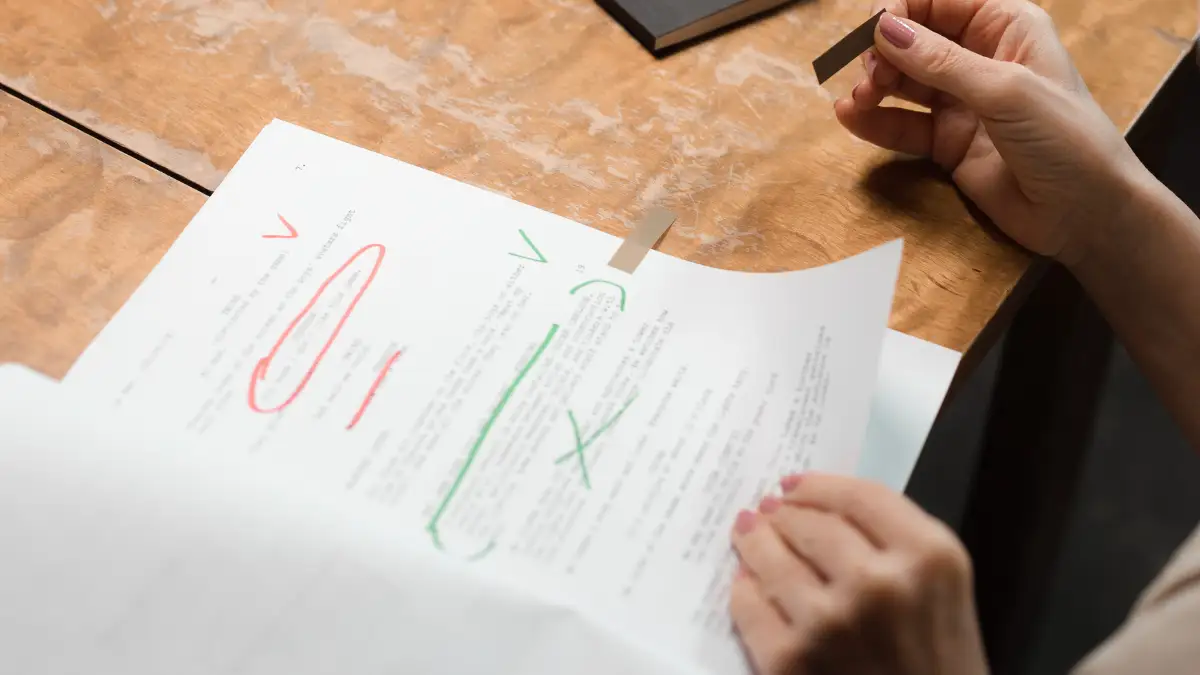
Contact Us
Get in touch with us using the form or details below. We look forward to hearing from you!


As one New York-based acting school states in their motto ‘Think before you act, so that you can act before you think.’ So how do we achieve this?
All the answers for how to approach your performance are hidden within the script, waiting for you to discover them and use them to deliver a stellar performance.
Script analysis is an art form that goes well beyond understanding and memorising lines and implementing stage directions. Mastering it involves deciphering the intricacies of characters, unravelling the layers of the story, and immersing oneself in the world created by the playwright or screenwriter.
In this detailed guide, we will explore advanced techniques for script analysis that are specifically geared towards seasoned actors. From dissecting characters to unravelling narrative arcs, these methods will empower you to bring depth, authenticity, and nuance to your performances.
The Meisner Technique emphasises truthful behaviour, emotional authenticity, and natural responsiveness to stimuli.
Equally, script analysis is intended to help actors gain an in-depth understanding of their characters, relationships, and motivations.
Both prioritise finding the truth and deeper meaning. This makes script analysis and the Meisner Technique the perfect pairing that allows actors to deliver exceptional performances with truly enriched portrayals of unmatched complexity and depth.
In-depth character exploration helps an actor identify the objectives, obstacles, and emotional truths that are driving a character.
As an experienced actor, this means digging deeper and employing some more detailed methods such as:
Dive deep into the psyche of your character by conducting a psychological profile. This means exploring their motivations, fears, desires, and internal conflicts. You should also consider their past experiences, traumas, and upbringing, looking at how these factors might shape their behaviour and decision-making.
One great way to do this is to use techniques such as:
During this process, you should also look for any contradictions and inconsistencies within the character. Identifying and understanding these nuances can add further complexity and depth to your portrayal.
Spending time mapping out your character’s emotional journey throughout the script can help you pinpoint key idiosyncrasies, transitions, and turning points that drive their individual story arc.
Pay special attention to the triggers and catalysts that elicit emotional responses from your character. Analysing how external events and interactions impact their emotional state and behaviour will help you more accurately respond to these as your character during a performance.
Experimenting with various emotional exercises, such as sense memory, emotional recall, and affective memory can be a great way to access the authentic emotions required for each scene.
Subtext refers to the underlying meanings, intentions and unspoken thoughts that enrich the dynamics of a scene. Uncovering the subtext beneath your character’s dialogue, actions, and interactions is key to properly understanding and inhabiting them.
This means you need to explore the gap between what your character says and what they truly mean or feel in that moment. Look for subtextual clues, nonverbal cues, and hidden agendas in the script that reveal even deeper layers of characterisation for you to work with.
Try engaging in some subtextual exercises, such as playing with opposite intentions, exploring power dynamics and playing around with alternative subtextual interpretations. These can help you identify important layers within the script that are also driving your character.

Once you have a strong grasp on your character, then it is time to analyse the story and work out the finer details of how the character fits into this. Rather than simply familiarising yourself with the story, as an established actor, you should be deconstructing it through:
Deconstruct the script, pulling apart its structure to discern its underlying framework and narrative dynamics. Not only about the main storyline, you must also pinpoint and work through any subplots or parallel storylines as you go too.You should focus on identifying the:
This process also involves a detailed analysis of the dramatic structure, pacing, and rhythm of the script. Pay close attention to how tension, conflict, and momentum are used throughout as this heavily impacts the storytelling.
Researching the context of a particular setting, time period and/or cultural environment used in the script is strongly recommended. This helps to educate and familiarise yourself with the historical, social and political context in which the story unfolds for a more accurate portrayal.
Investigate any relevant references, allusions, or symbols used within the script and look at how these contextual elements enrich the story. It is also worth weighing up how these may also inform the characters’ perspectives and motivations.
Research can include activities such as:

A core element of the Meisner Technique, understanding and leveraging the dynamics between your character and other characters within the script is vital to script analysis and genuine performances.
Evaluate the relationships, power dynamics, and emotional connections between everyone in the narrative. This means exploring conflicts and alliances and how each character’s objectives and motivations intersect and influence the overall trajectory of the story.
This is a good time to collaborate with your fellow actors. Through rehearsing and exploring ensemble scenes together you facilitate greater authenticity, spontaneity, and emotional resonance in your interactions.
Once you’ve done a deep dive into your character and pulled apart the script, it is time to put everything you have learned back together and apply it to your performance.
You can do this by:
Making Character-Driven Choices. Ground your performance through the insights learned from your character analysis. Make bold, specific choices that align with your character’s psychology, objectives, and emotional truth.
Practicing Narrative Immersion. Place yourself fully in the world of the script, surrendering to its themes, conflicts, and emotions. Cultivate a sense of empathy and connection with your character, their journey and the broader themes within the story.
Script analysis is a complex skill that to master requires dedication, curiosity, and a commitment to truth and authenticity.
At The Actors Pulse, we support you in honing your skills in character and story analysis, giving you the tools you need to unlock the full potential of your performances.
For beginners, this is a core foundational aspect of learning your craft. As an experienced actor, it is one of the greatest steps you can take towards elevating your craft to new heights and leaving a lasting impact on your audiences.
To learn more about our course curriculum and how we can support you in mastering script analysis for truly outstanding performances, call The Actors Pulse today at 0414 475 515.









Get in touch with us using the form or details below. We look forward to hearing from you!
